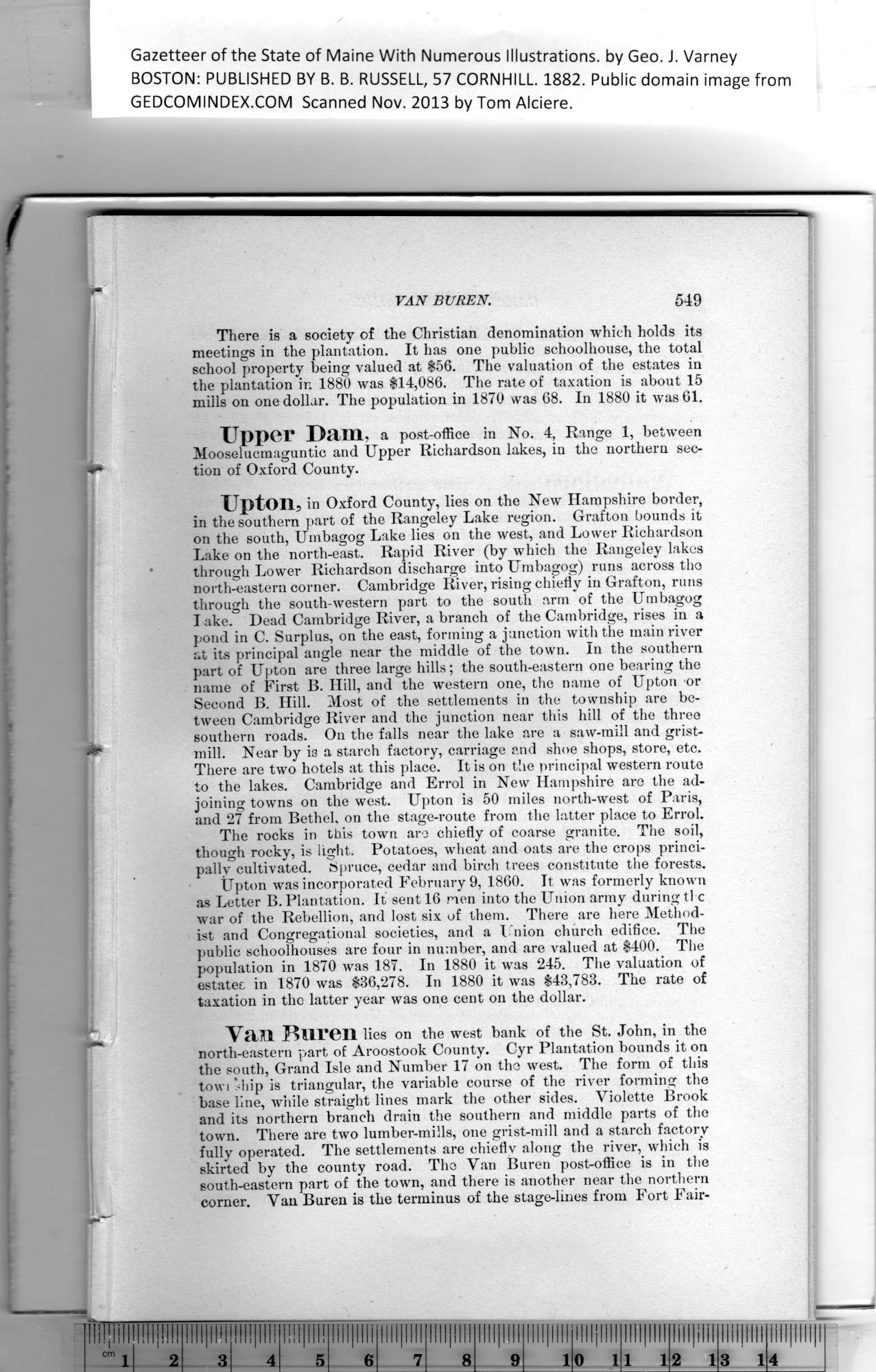|
Gazetteer of the State of Maine With Numerous Illustrations, by Geo. J. Varney
BOSTON: PUBLISHED BY B. B. RUSSELL, 57 CORNHILL. 1882. Public domain image from
VAN BUREN. 549
There is a society of the Christian denomination which holds its
meetings in the plantation. It has one public schoolhouse, the total
school property being valued at $56. The valuation of the estates in
the plantation in 1880 was $14,086. The rate of taxation is about 15
mills on one dollar. The population in 1870 was 68. In 1880 it was 61.
Upper DRU1, a post-office in No. 4, Range 1, between
Mooselucmaguntic and Upper Richardson lakes, in the northern sec-
tion of Oxford County.
UptOIl, in Oxford County, lies on the New Hampshire border,
in the southern part of the Rangeiey Lake region. Grafton bounds it
on the south, Umbagog Lake lies on the west, and Lower Richardson
Lake on the north-east. Rapid River (by which the Rangeiey lakes
through Lower Richardson discharge into Umbagog) runs across the
north-eastern corner. Cambridge River, rising chiefly in Grafton, runs
through the south-western part to the south arm of^ the Umbagog
I ake. Dead Cambridge River, a branch of the Cambridge, rises in a
pond in C. Surplus, on the east, forming a junction with the main river
at its principal angle near the middle of the town. In the southern
part of Upton are three large hills; the south-eastern one bearing the
name of First B. Hill, and the western one, the name of Upton or
Second B. Hill. Most of the settlements in the township are be-
tween Cambridge River and the junction near this hill of the three
southern roads. On the falls near the lake are a saw-mill and grist-
mill. Near by is a starch factory, carriage and shoe shops, store, etc.
There are two hotels at this place. It is on the principal western route
to the lakes. Cambridge and Errol in New Hampshire arc the ad-
joining towns on the west. Upton is 50 miles north-west of Paris,
and 27 from Bethel, on the stage-route from the latter place to Errol.
The rocks in this town are chiefly of coarse granite. The soil,
though rocky, is light. Potatoes, wheat and oats are the crops princi-
pally cultivated. Spruce, cedar and birch trees constitute the forests.
Upton was incorporated February 9, 1860. It was formerly known
as Letter B. Plantation. It sent 16 men into the Union army during ti c
war of the Rebellion, and lost six of them. There are here Method-
ist and Congregational societies, and a Union church edifice. The
public schoolhouses are four in number, and are valued at $400. The
population in 1870 was 187. In 1880 it was 245. The valuation of
estates in 1870 was $36,278. In 1880 it was $43,783. The rate of
taxation in the latter year was one cent on the dollar.
Vail Buren lies on the west bank of the St. John, in the
north-eastern part of Aroostook County. Cyr Plantation bounds it on
the south, Grand Isle and Number 17 on the west. The form of this
towi ship is triangular, the variable course of the river forming tbe
base line, while straight lines mark the other sides. Violette Brook
and its northern branch drain the southern and middle parts of the
town. There are two lumber-mills, one grist-mill and a starch factory
fully operated. The settlements are chiefly along the river,_ which is
skirted by the county road. The Van Buren post-office is in the
south-eastern part of the town, and there is another near the northern
corner. Van Buren is the terminus of the stage-lines from Fort Fair-
PREVIOUS PAGE ... NEXT PAGE
This page was written in HTML using a program written in Python 3.2
|
